EMEA Outlook: Elections Set the Scene in Q2
· Unlike South Africa and Russia, Turkiye continued with tightening monetary policy in Q1 due to stubborn inflation, pressure on FX and reserves. Meanwhile, Russia and South Africa halted their tightening cycles as of 2024 and will likely start cutting interest rates in Q3 depending on how soon inflation will return back to targets. EMEA outlook is currently affected by elections while domestic factors, geopolitics, global risks and China slowdown remain key factors.
· In Turkiye, Central Bank of Republic of Turkiye (CBRT) increased policy rate to 50% on March 21 to cool off galloping inflation, and will likely halt at this level until the end of 2024, if the inflation will not spin out of control and TRY weakening will not accelerate. Despite this tightening there are strong signs that inflation will stay high until June, but we foresee favorable base effects would start relieving the pressure after June. We foresee upside risks emanating from domestic demand, the stickiness of services inflation, and geopolitical risks would likely cause 2024 average inflation to stand at 58.8% as monetary tightening is still feeding through. On the growth front, we expect the economy to expand by 2.7% in 2024 and 3.2% in 2025, as high inflation, weakening currency and additional quantitative and macro-prudential tightening steps continue to dent GDP growth.
· In South Africa, we foresee headline inflation will fall to 5.1% and 4.7% in 2024 and 2025, respectively, thanks to South Africa Reserve Bank’s (SARB) sensitivity to inflation and as power cuts (load shedding) is expected to be partly relieve. We feel SARB will start cutting interest rates in Q3 2024, but the pace will vary depending on how soon inflation will approach to target levels. We foresee some moderate political volatility in Q3 as presidential elections will be held on May 29. We expect a coalition government (75% chance) bringing some political uncertainty, and this is likely to struggle with structural issues that the country faces. We see a stronger growth of 1.2% and 1.4% in 2024 and 2025, respectively, particularly if the country will be able address the electricity shortages, logistical constraints, and financing needs but new government’s determination will be key. We envisage investment in machinery and equipment for energy production and household spending to remain strong.
· In Russia, macroeconomic instability continues due to current account surplus shrinking, inflation spiking, and ruble (RUB) weakening. On the war front, we foresee a continued stalemate in 2024 as the Ukraine war remains deadlocked unless Donald Trump is elected U.S. president in November and threatens to curtail Ukraine funding. The inflation projections stay stronger than expected particularly due to a weaker RUB, demand-cost pressures stemming from high demand and lending. Taking into account restrictive monetary policy partly suppresses prices with lagged impacts, we feel cooling off inflation will not be straightforward as it is likely that the inflation would remain higher than Central Bank of Russia’s (CBR) expectations particularly in H1 2024, partly due to base effects, tight labor market and high military spending. We envisage annual average inflation to record 6.7% in 2024, and think CBR will likely consider cutting rates in Q3, if inflation allows.
· Forecast changes: From our December outlook, we have increased the GDP forecast both for Russia due to higher-than-expected military spending, and strong consumer demand. We revised end-of-2024 key rate forecast to 50% for Turkiye as CBRT resumed the tightening cycle on March 21. We also foresee South Africa will start cutting policy rate in Q3, not in Q2 since stubborn inflation in 2024 stays far from the 4.5% mid target point so far.
Our Forecasts
 Source: Continuum Economics
Source: Continuum Economics
Risks to Our Views
 Source: Continuum Economics
Source: Continuum Economics
EMEA Dynamics: Inflation Still High, Elections Set the Scene in Q2
EMEA economies continue to be squeezed by macroeconomic problems such as stubborn inflation and financial pressures. We think elections, country specific factors, geopolitics, and likely rate cuts by the DM economies will rule the EMEA outlook in 2024.
Inflation remains the major concern for EMEA as they stay above the targets in all major EMEA countries despite restrictive monetary tightening cycles in 2023. South Africa and Russia halted the cycles in 2024 so far and are waiting the right time to start cutting rates, probably in Q3. Turkiye lifted the policy rate to 50% on March 21, and we think the policy rate will be kept stable until the end of 2024, if inflation would not necessitate further rate hikes.
We also see upward inflationary risks remaining strong. DM countries could see stronger lagged effects on the economy from the 2022-23 monetary tightening that could prolong the EZ/UK recession or move the U.S. slowdown towards stagnation or a mild recession, which could negatively affect EM economies coupled with a China slowdown. We think slowdown in DM and China would risk greater uncertainty over the EMEA medium-term prospects. Additionally, EZ/UK recession could particularly hurt Turkish exports to the EU/UK as both remain among the major trading partners for Turkiye. These are our alternative scenarios rather than our baseline. We continue to view election-related-populist spending putting further pressure on already struggling government budgets in Q1 and Q2 2024. We foresee fiscal positions to deteriorate during the rest of 2024, contributing both to the GDP and inflation prospects.
EM FX outlook projections are dominated by domestic fundamentals and elections. Fed easing in H2 2024 could help EMFX more broadly and allow slower declines or recovery in spot rates. We think particularly South Africa can use it as an opportunity to cut rates or build FX reserves.
Figure 1: South Africa, Russia and Turkiye Inflation (%, YoY), February 2021 – February 2024

Source: Datastream, Continuum Economics
South Africa
In South Africa, our headline inflation forecast for 2024 is at 5.1%, before declining to 4.7% in 2025 due to the lagged impacts of SARB’s previous tightening, partly relieved power cuts (load shedding) and easing private consumption growth. Despite these, risks to the inflation outlook are still assessed to the upside as acceleration in food, fuel and electricity prices continue to present inflationary risks, along with logistical constraints. The weakening currency is another risk factor for the inflation outlook as its importance extends beyond direct import prices to inflation expectations, as South African Rand (ZAR) slipped only around 3.2% in February contributing to the 5.6% YoY inflation reading.
Despite load shedding issue partly easing in January, the country faced the most severe nationwide power cuts in months mid-February, as Eskom implemented Stage 5 and Stage 6 outages due to numerous factors such as shutdown of generating units, the need to continue to do planned maintenance, and excessive demand. As we noted in the December outlook, the country had targeted lifting the share of renewable energy in its power generation mix from 11% currently to 41% by 2030, and we think both private and government investments may accelerate in 2024 and 2025, despite major reforms having to wait on the 2024 election outcome. The new government’s determination in dealing with load shedding will be a key factor in increasing the supply of electricity in the near term.
Strong SARB tightening in 2023 is still feeding through in Q1 2024 with lagged impacts. We think the recent increase in the inflation figures, particularly inflation jumping from 5.1% in December 2023 to 5.6% YoY in February 2024 due to higher housing & utilities, food and transport prices will likely cause SARB to act cautiously, and be wary of potential risks to the outlook as the inflation remaining within SARB’s target of between 3% and 6%; but still far from the 4.5% midpoint. (Note: According to the data released on March 19, average inflation expectations for 2024 and 2025 also remained well above that midpoints igniting some SARB concern).
Taking into account that SARB Governor Kganyago has repeatedly said the job of taming inflation is not done yet, and the central bank will be unwilling to adjust its policy stance until inflation retreats to 4.5% in a sustainable manner and settles there, we think stronger-than-expected inflation figures could cause SARB to delay the rate cuts to Q3 and after the elections, if the CPI trajectory allows in the upcoming moths. This is also related with the elections outcome as a coalition with an uncertain fiscal and load shedding policy could delay easing further. We expect the first rate cut could happen either on the MPC meeting scheduled on July 18 or on September 19. Our end year prediction is 7.5% for 2024 policy rate, and 6.5% for 2025.
On the currency front, we expect the economy will be still supported by a trade surplus in 2024 coupled with probable Fed and ECB easing pressure on the ZAR, which can increase investor’s appetite for South Africa, but we expect a moderate fall in the trade surplus mostly due to global slowdown, particularly China. We think Fed easing in H2 2024 should help ZAR as South Africa can use it as an opportunity to cut rates or build FX reserves.
On the growth end, we assess the economy will grow by 1.2% in 2024, particularly if the country will be able address the electricity shortages, logistical constraints, and financing needs. Our predictions are in line with SARB’s growth forecast in January, which remained unchanged for 2024 and 2025 at 1.2% and 1.3%, respectively. (Note: South African Treasury announced in February that it expects the economy to expand by 1.3% in 2024, and 1.6% in 2025). We foresee investment in machinery and equipment for energy production to remain strong, and less severe load shedding and long-term electricity production in the medium term. We also think there are downside risks to growth; as households continue struggling with finding spare funds in an environment of high interest rates, and businesses facing a tough domestic environment including high lending rates and high costs of doing business. This situation could be reversed somewhat after SARB would start cutting the policy rate, and lending rates would start likely coming down in Q4 of 2024.
On the fiscal trajectory front, public finances weakened in 2023 and the country still has need for large domestic and international financing. Compared to a year ago, the budget deficit for 2023/24 in South Africa is estimated to worsen from 4% to 4.9% of GDP. (Note: Finance Minister Godongwana noted in his budget speech on February 21 that that debt-service costs will absorb more than 20% of revenue, and said “To put this into perspective, spending on debt-service costs is greater than the respective budgets for social protection, health, or peace and security”). We think the government fiscal balance and debt trajectory would remain cloudy as of 2024 as fiscal room remains limited to fund structural reforms, productive investments, social spending needs and renewable energy efforts despite effort enhancing revenue collections, and improving the institutional fiscal framework. It appears May 29 election spending does not help the fiscal outlook to improve either.
On the political front, we foresee two possible outcomes of South African presidential elections on May 29, either an African National Congress (ANC) win or a coalition government. It seems ANC is at the risk of losing its majority as the recent polls suggest support for the ANC has dipped below 50% due to power cuts, unemployment, inequality, and the rising cost of living. Unless something unforeseen occurs, we think the ANC will likely remain below the absolute majority, and a coalition will have to be formed, either with Democratic Alliance (DA) or with other smaller parties. The radical Economic Freedom Fighters (EFF) will be the key determinant of the election since the growing support to EFF continues to eradicate support to ANC. We see some moderate and temporary political volatility during and after the elections.
Figure 2: CPI, Core Inflation (YoY, % Change) and Policy Rate (%), January 2023 – February 2024
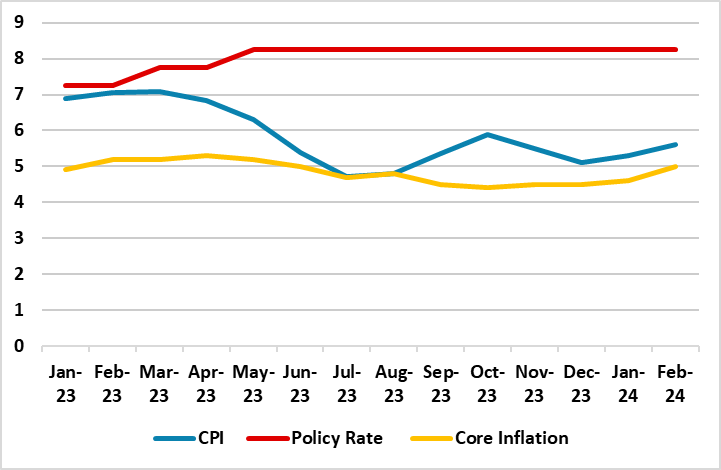
Source: Continuum Economics, Datastream
Figure 3: SARB Interest Rate Forecast (%), 2017 - 2026
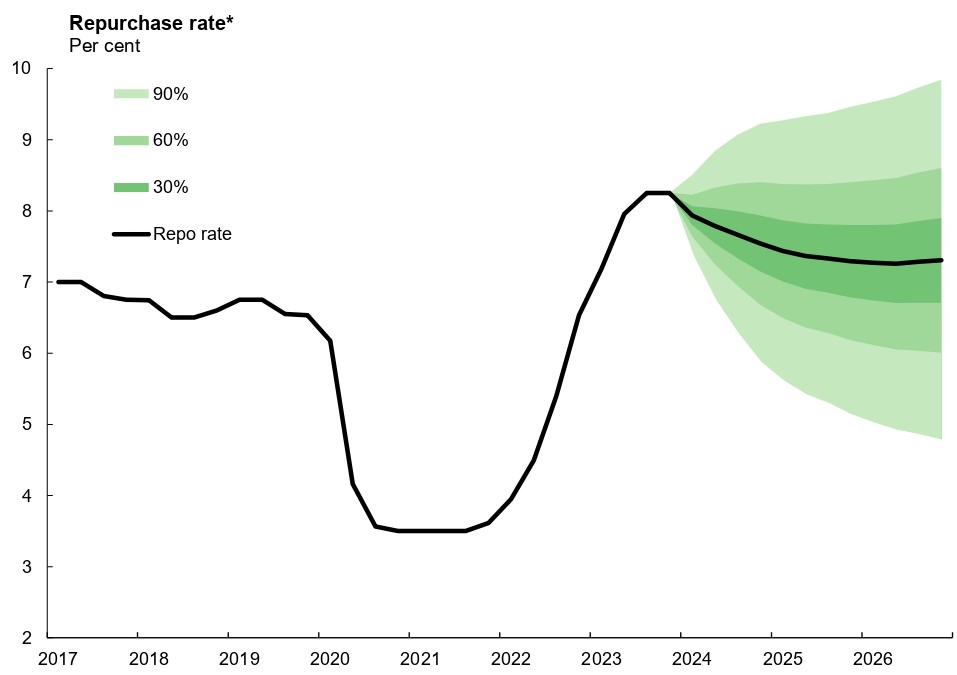
Source: SARB January 2024 MPC Statement
Turkiye
Galloping inflation, increasing budget deficit, and weakening Turkish Lira (TRY) continue to be the major concerns over the Turkish economy, and we expect macroeconomic instability to remain acute in spite of various actions by the government to improve the current outlook.
Despite the economy expanded by a strong 4.5% in 2023 backed up by buoyant demand, high government expenditure and investments during the year of presidential election and twin earthquakes; we expect GDP growth to slow down in 2024. This is mainly due to continued feedthrough of tightening by the Central Bank of Republic of Turkey (CBRT), additional macro prudential policies and fiscal actions suppressing demand and lending. We foresee GDP growth will stand at 2.7% in 2024 and 3.2% in 2025 as CBRT’s hawkish bias and stubbornly high inflation continue to moderate household consumption. We envisage that CBRT would likely keep the key policy rate stable at 50% in 2024 basically to cool off inflation, and this could also suppress GDP growth.
We stipulate contractionary fiscal policies such as increases in taxes can help slightly relieve the pressure in 2024, but incessant hikes in the minimum wage and premium payments to retirees could complicate the situation. We see government’s ongoing local election spending and earthquakes related expenditures continue to hurt the budget.
Balance-of-payments data published on February 13 showed the current account deficit (CAD) shrank to $45.2 billion in 2023, from $49.1 billion in 2022 helped by slight fall in the trade deficit, which is good news for the economy. Despite increasing geopolitical risks and volatile global energy prices which could put further pressure on Turkish current account balance (CAB) in 2024, we think slowing domestic demand thanks to aggressive monetary tightening, coupled with strong services trade balance and tourism revenues likely heal CAD in 2024. The government hopes to fill in the gap by additional tourism revenues or via hikes in the export revenues triggered by TRY weakening.
Inflation remains the core economic problem. Our forecast for the annual average inflation is 58.8% and 35.3% in 2024 and 2025, respectively. Firstly, we think CPI will start declining in the second half of 2024 partly due to favorable base effects, lagged impacts of tightening cycle, and additional quantitative and macro-prudential tightening steps since the February MPC, but will likely remain considerably high than 30% until the end of 2025 as the measures to contain inflation have lagged impacts. High inflationary expectations and broken demand-supply balance continue to have broader effects on the cost of living. We anticipate buoyant demand, the stickiness in services inflation, weakening currency, deteriorated pricing behavior, hike in public spending before local elections and geopolitical risks keep inflation pressures alive in H1 2024. (Note: Turkish CPI surged to 67.1% annually and 4.5% monthly in February, and annual inflation swung to a 15-month high due to increases in hotel, education and food prices).
Given forward guidance by the CBRT with disinflation beginning in H2 2024, and macroeconomic stability forecast beginning in 2025, we are of the view that CBRT has shown determination by hiking the rate from 8.5% to 50% as of Q1. The most important part of the story is the Central Bank continues to regain credibility as it strongly signals determination in pursuing traditional economic policies until the inflation is under better control, which could probably help attract foreign investments, but restoring full-confidence will take time. Despite inflation readings could put further pressure on CBRT to resume tightening cycle in the upcoming months, we foresee CBRT to hold the key rate constant at 50% through the end of 2024.
As we underlined in the December outlook, the Turkish inflationary outlook is still affected by the monetary illusion. First, after the steep hikes in the minimum wage and salaries of the civil servants in early 2024, Turkish people have had the tendency to view their wealth and income in nominal terms, rather than recognizing their real value adjusted with galloping inflation, which triggered the consumer demand to increase, as skyrocketing inflation created the public's concern that 'everything will become more expensive'. In addition, as the real interest rates were negative, we think people mostly stopped saving and tended to spend their income as quickly as possible before they would lose their purchasing power. As the real interest rates are not deeply negative anymore following CBRT’s steep rate hikes, we think this vicious cycle (inflation becoming the cause of the increase in demand, and the increase in demand becoming the cause of inflation) could be partly broken, helping the inflation to cool off, under the assumption that inflation will partly relieve in H2 of 2024. This could also mean downside risks to GDP growth, if it reduces demand growth and ensures monetary policy tightening bites more than expected – data at the moment does not back this idea.
On the currency front, slowing the pace of TRY decline is important in cooling down inflation given FX pass-through from a weak TRY as currency fluctuations continue to prevail. We continue to see losses for TRY as foreign capital inflow remains weaker-than-expected, and we see the USD/TRY rate at 37.5 by the end of 2024. TRY losses set to accumulate on still wide inflation differentials and domestic vulnerabilities.
On the political end, local elections will be held on March 31. Unless something unforeseen occurs, we think Justice and Development Party (AKP) will likely remain the highest rated party in the Turkish local elections, winning more local municipalities than any other parties in Turkiye. Despite AKP’s main target is to win back the major cities such as Istanbul, Ankara and Izmir, the recent polls foresee that Ankara and Izmir will likely remain administered by a Republican People’s Party (CHP) mayor, while election outcome for Istanbul remains too close to predict. It appears the votes to New Welfare Party (YRP), Good Party (IYI Party) and Peoples’ Equality and Democracy Party (DEM) will be the key determinants since the growing support to YRP will likely dent support to AKP, and DEM and IYI Party would eradicate support to CHP, particularly in the metropolitan cities. We see no major political volatility during and/or after the elections.
Figure 4: CPI, PPI, Core Inflation (YoY, % Change) and Policy Rate (%), February 2023 – February 2024
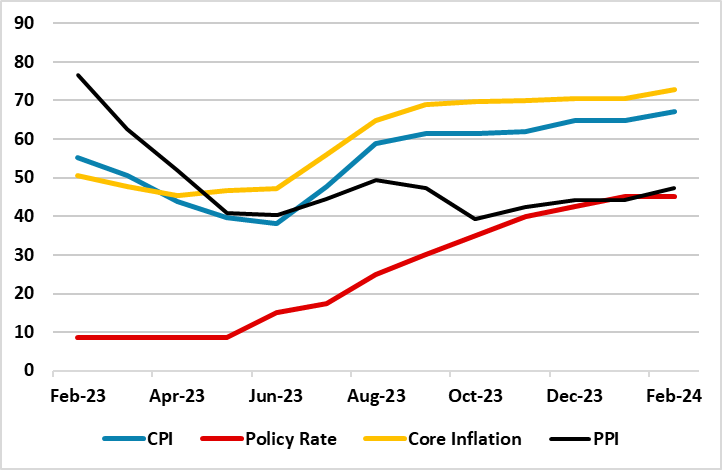
Source: Continuum Economics
Figure 5: Turkish Foreign Trade (Million USD), January 2023 – January 2024
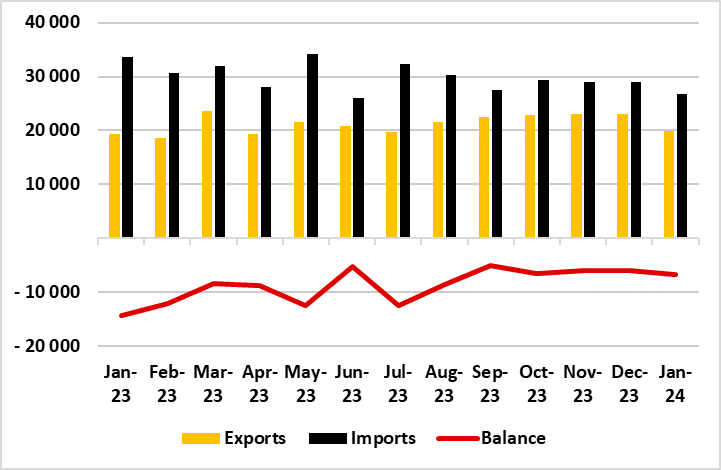
Source: Continuum Economics
Russia
Taking into account that the foreign trade surplus is shrinking, inflation is spiking, ruble is weakening and the Ukraine war is dragging on, we foresee macroeconomic instability to remain substantial in 2024 and in 2025, particularly if the Ukraine war would continue, as expected.
On the growth front, the Russian economy expanded by a strong 3.6% YoY in 2023 despite the cloudy macro outlook. The main driver for the GDP growth remained the surge in military spending, supported by the improved consumer demand amid greater outlays on social support, higher wages and strong lending. Despite 2023 growth figure, we anticipate a slowdown in GDP growth in 2024 (+1.9%) and in 2025 (+1.1%). First, we think the effects of strong monetary tightening are now more explicit partly suppressing demand and imports, and offsetting increased fiscal impulses. Additionally, sanctions on Russia’s energy sales leading to a steady weakness in export revenues, coupled with severe staff shortages and falling trend in the utilization rates continue to jeopardize the GDP expansion in 2024. (Note: CBR announced on February 27 that consumer demand continues to remain higher than expected, but has recently started reacting to tight monetary policy, and added that the growth of the corporate loan portfolio paused in January, after its quick expansion by 1.8% in December 2023. Mortgage lending also recorded a decline and dropped from 2.9% in December 2023 to 0.6% in January 2024).
Inflation, which started to surge particularly after June last year, continues to stay higher than the government’s projections. Inflation is far above the CBR’s 2024 forecast range of 4%-4.5%, and CBR’s medium term target of 4%, as February inflation stood at 7.7% YoY. We think inflation risks is still tilted to the upside, and it is likely that the inflation would remain high in H1 2024, due to high military spending, weakening RUB, tight labor market, risking inflation to stay high and we predict annual average inflation to stand at 6.7% in 2024. Domestic demand continues to be stronger than the production of goods and services as tight labor market restraining the expansion of output. (Note: The unemployment rate declined to a historical low of 2.9% in January). Additionally, the RUB weakness continues to cause concerns over the inflation trajectory as RUB weakened by around 20% against the dollar in 2023, and lost 1.4% of its value in February. We expect RUB would remain weak and volatile in the rest of 2024 since the sanctions continue to hurt and the weakness of the currency can still adversely impact inflationary expectations and pressures.
Inflation is projected to slow down in H2 2024 as strong monetary tightening in the second half of 2023 could suppress demand and imports and squeeze lending particularly, but only gradually with lagged effects. CBR will likely start cutting rates in Q3 if inflation starts cooling off, RUB stabilizes and inflation expectations would converge to CBR’s forecasts. However, this will not be very straightforward given Ukraine war continues to dominate Russia economic outlook. Our end-year key rate forecast is 14% and 9% end 2025. (Note: The CBR raised its forecast for its average key rate range to 13.5-15.5% from 12.5-14.5% for 2024 in February, suggesting that easing borrowing costs will take longer than previously thought).
In addition to falling trade surplus due to war-related sanctions, it appears the things are not going in the right direction on the budget end. According to the Finance Ministry figures, Russia’s federal budget deficit in 2023 amounted to RUB 3.24 trillion ($36.4 billion), with total revenues increasing 4.7% YoY to RUB 29.12 trillion and spending climbing by 4% to RUB 32.36 trillion. (Note: Russia’s budget deficit of 1.9% of GDP in 2023 improved from 2.3% in 2022, but still missed the government's initial target). A 25% increase in non-oil and gas revenues in 2023 counteracted a 23.9% drop in energy revenues as Western sanctions, including an oil price cap and embargo.
We continue to foresee a rise in the budget deficit in 2024. Military analysts assert that Russian spending on defense will rise to around 6% of GDP in 2024 while it was 3.9% of GDP in 2023. (Note: According to official information, Russia spends 29% of all public expenditures on defense, while the NATO average is only 4.3%). We think this figure would be probably larger when considering the reconstruction expenditures in occupied parts of Ukraine, and this continues to contribute to the financial burden.
On the war end, the deadlock in Ukraine continues to hold as of winter months, and protracted conflict remains active as both sides fail to gain ground. The support to Ukraine from the Western Block remains fragmented despite European Union (EU) leaders agreed on February 1 to extend EUR 50 billion in aid for Ukraine’s recovery, reconstruction, and modernization. Though the U.S. Senate advanced a wartime aid package for Ukraine on Feb. 8, we foresee this will likely fail in the House. Meanwhile, we think Putin hopes that Trump is reelected as U.S. president in November, splits western support and leading to a probable Russia-friendly peace deal with current territories. Europe would likely step up military support if a president Trump curtails support, but it would likely be modest given disagreements within the EU. The Ukraine war continues to create an increasing financial burden on Russia due to high military spending in addition to aggravation of staff shortages.
On the political front, Russia chose its president on March 17, and as expected, Putin won the elections receiving 87% of the votes, the highest ever result in Russia's post-Soviet history. As the opposition remains weak, Putin will be in office until at least 2030 by securing his fifth term in Kremlin, despite alleged concerns that the election was not executed under free and fair conditions. Taking into account that Putin is now reelected, we foresee he will not accept restoring Ukraine’s borders willingly, and as noted above, wait for the possibility of a Trump win in the U.S. elections. If Biden is elected U.S. president, the war will likely remain a stalemate for a longer time without a peace deal.
Figure 6: GDP Growth (%, YoY), 2014-2023
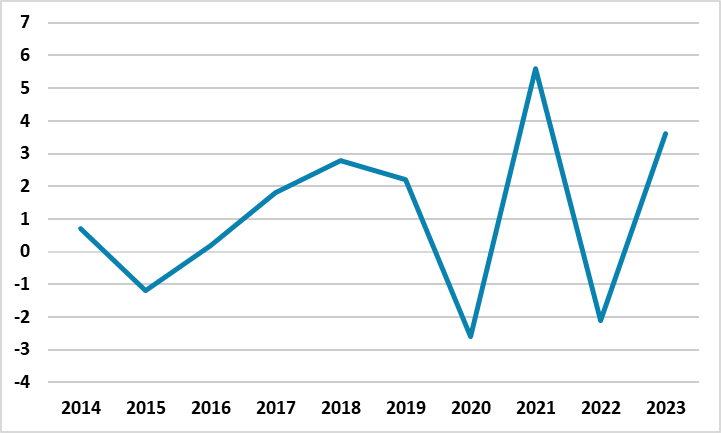
Source: Continuum Economics
Figure 7: Policy Rate (%) and CPI (YoY, % Change), January 2022 – February 2024

Source: Continuum Economics